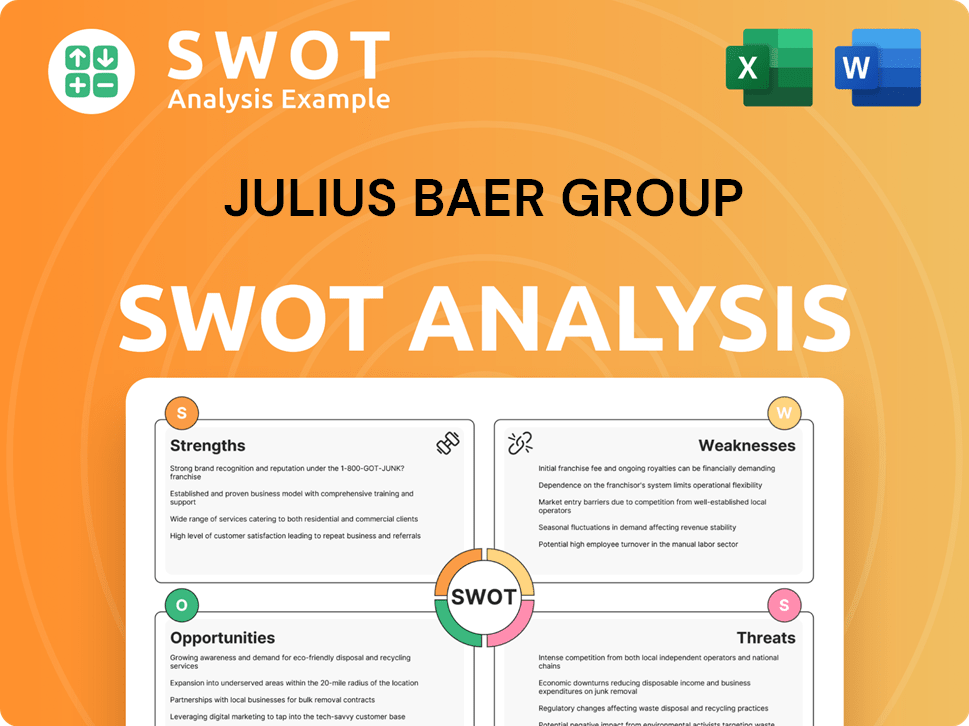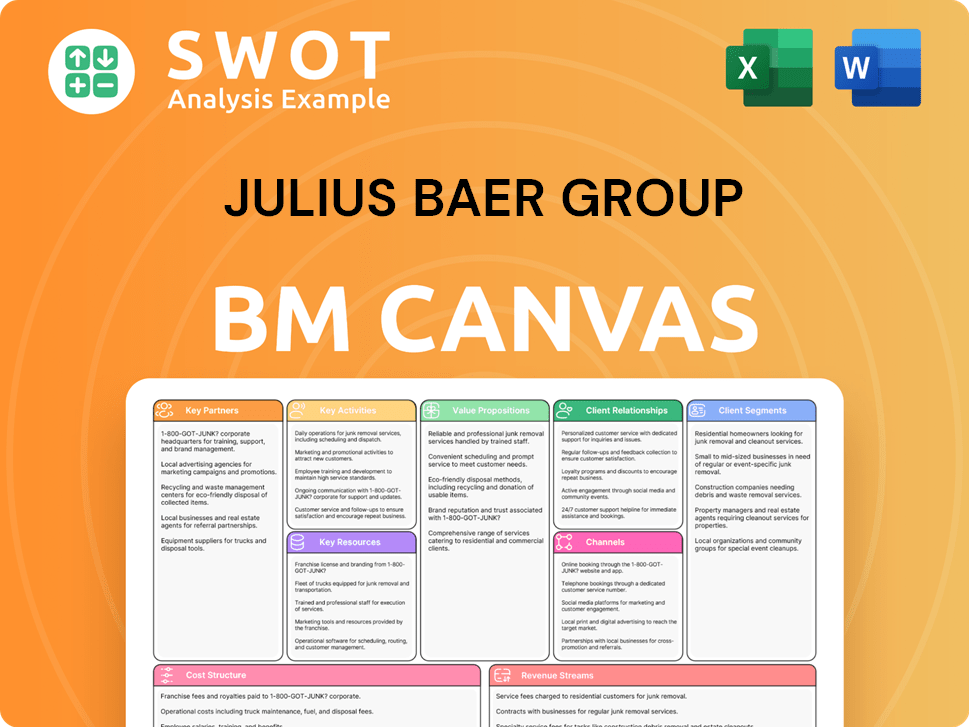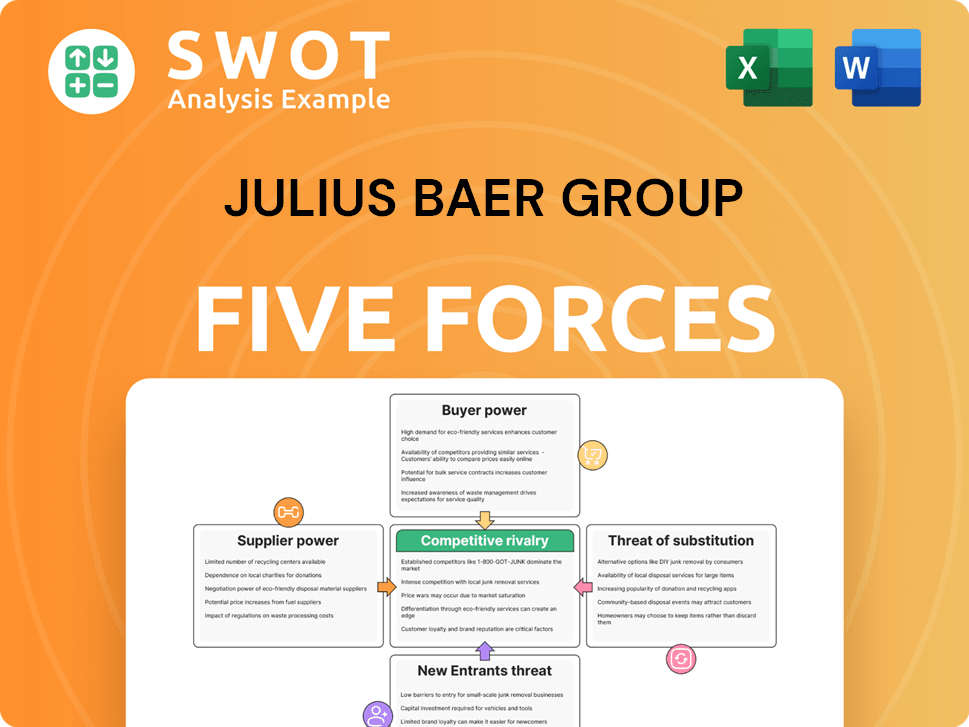Julius Baer Group Bundle
How did Julius Baer become a global wealth management powerhouse?
Delve into the captivating Julius Baer Group SWOT Analysis to understand the company's journey. From a modest bureau de change in 1890 Zurich, Switzerland, to a leading Swiss private bank, Julius Baer's story is one of remarkable growth and strategic adaptation. Discover how this financial services giant has navigated over a century of market changes to become a cornerstone of global wealth management.

The brief history of Julius Baer reveals a commitment to personalized banking and investment advisory services. This commitment, coupled with strategic acquisitions and a focus on client needs, has propelled Julius Baer Group to the forefront of the wealth management industry. Exploring the Julius Baer history provides valuable insights into the evolution of financial services and the dynamics of the global market. The company's resilience and adaptability are key takeaways for anyone interested in the Swiss private bank's success.
What is the Julius Baer Group Founding Story?
The story of the Julius Baer Group begins on October 17, 1890, in Zurich, Switzerland. It started as a general partnership, Hirschhorn & Grob, evolving from a small bureau de change. This marked the initial step in the Julius Baer history, recognizing Zurich's rising importance in international trade.
In 1896, Julius (Isaac) Baer joined the partnership. He later changed his name to Julius in 1897. His arrival transformed the firm into Hirschhorn, Uhl & Baer. This was a crucial moment in the Julius Baer company timeline, setting the stage for its future as a leading Swiss private bank.
Julius Baer's background included a banking apprenticeship and experience at Samuel Dukas & Co. in Basel. He was sent to Zurich by his brother-in-law, Ludwig Hirschhorn. He saw an opportunity to move beyond currency exchange into wealth management, FX trading, and securities dealing. In 1901, after Ludwig Hirschhorn's death, Julius Baer took over the business, renaming it Julius Baer & Co. and securing a seat on the Zurich stock exchange, which is when the bank was formally born under his leadership.
The firm's initial focus was on providing personalized, high-quality banking services to wealthy individuals and families. This approach was built on financial stability and a conservative banking strategy. The early funding came from partnerships, typical of family-run businesses at the time. Julius Baer's sons, Richard, Walter, and Werner, later joined the bank, continuing the family's involvement.
- Julius Baer established the bank in 1901, marking a significant point in the Julius Baer founding date.
- The bank's initial focus was on personalized banking services for affluent clients, a core aspect of its wealth management strategy.
- The firm's early funding was likely self-sustained or through partnerships, reflecting its origins as a family-run business.
- The bank's commitment to financial stability and a conservative approach has been a hallmark of its financial services.
The bank's early success was built on personalized service and a commitment to financial stability. This foundation allowed Julius Baer to build a strong reputation within the Swiss private bank sector. The bank's early strategies and values are still reflected in its operations today. For more insights into the bank's guiding principles, you can explore Mission, Vision & Core Values of Julius Baer Group.
Julius Baer Group SWOT Analysis
- Complete SWOT Breakdown
- Fully Customizable
- Editable in Excel & Word
- Professional Formatting
- Investor-Ready Format

What Drove the Early Growth of Julius Baer Group?
The early growth of Julius Baer marked a significant shift from a simple exchange office to a more comprehensive financial services provider. This expansion included wealth management, securities, and FX trading, which remain central to its business today. The company's growth was fueled by strategic international moves and pivotal financial decisions. This period laid the foundation for its future as a leading Swiss private bank.
The international expansion of Julius Baer began in 1940 with the establishment of the Baer Custodian Corporation in New York. This was a crucial step in establishing a global presence. Further expansion included the launch of Baer Securities Corporation in New York in 1962 and a subsidiary in Mexico in 1966. These early moves set the stage for future growth in key financial markets.
Julius Baer's expansion strategy included key acquisitions and the establishment of subsidiaries. The opening of Julius Baer International Ltd. in the UK in 1968 was a significant milestone. In 1986, the acquisition of Société Bancaire further strengthened its position. These strategic moves helped to broaden its service offerings and client base.
In 1980, Julius Baer became the first Swiss private bank to go public, which provided capital for expansion. Despite this, the Baer family maintained control until 2005. Further acquisitions, like Bank Falck & Co. in Lucerne in 1997, and the opening of offices in Vienna and Milan, demonstrated a commitment to growth. For more details on the ownership structure, you can read about the Owners & Shareholders of Julius Baer Group.
This strategic expansion and capital raising allowed Julius Baer to significantly increase its scale and accelerate its growth, particularly into global growth markets like Asia. By the late 1990s and early 2000s, Julius Baer had established a strong presence in Europe and was beginning to focus on emerging markets. This growth trajectory positioned the company for future success in the global financial services landscape.
Julius Baer Group PESTLE Analysis
- Covers All 6 PESTLE Categories
- No Research Needed – Save Hours of Work
- Built by Experts, Trusted by Consultants
- Instant Download, Ready to Use
- 100% Editable, Fully Customizable

What are the key Milestones in Julius Baer Group history?
The Julius Baer Group has a rich history marked by significant achievements and strategic pivots within the financial services industry. Key milestones have shaped the Julius Baer history, contributing to its evolution as a leading Swiss private bank.
| Year | Milestone |
|---|---|
| 1980 | Became the first Swiss private bank to go public, securing capital for international expansion. |
| 2005 | Restructured, forming Julius Baer Group Ltd. and adopting the 'one share, one vote' principle, leading to strategic acquisitions. |
| 2024 | Launched an e-signature service for clients in Asia and integrated the Sophisticated Professional Investors (SPI) framework in Hong Kong. |
| 2024 | Received the Google AI Trailblazers Innovation Award for its AI-Agent Narrative Generation Engine. |
The company has consistently embraced innovation to enhance its services and client experience within wealth management. This includes leveraging technology to streamline processes and offer advanced solutions.
Launched an e-signature service for clients across Asia in 2024, enhancing convenience and efficiency. Also, scaled an AI-powered voice-to-text transcription service.
Awarded the Google AI Trailblazers Innovation Award in 2024 for its proprietary AI-Agent Narrative Generation Engine. This highlights its commitment to leveraging AI for financial services.
Fully integrated the Sophisticated Professional Investors (SPI) framework in Hong Kong in October 2024, streamlining pre-trade disclosures. This ensures compliance and improves client transparency.
Despite its successes, Julius Baer has encountered challenges, including regulatory issues and financial setbacks. The company's response involves strategic adjustments to improve its financial performance and strengthen its market position.
Incurred substantial credit losses in 2023 from loans to the collapsed Signa Group, leading to a 15.9% decrease in operating revenues. This prompted a review of its credit portfolio.
Exited its private debt business in 2024 and implemented aggressive cost-cutting measures, targeting CHF 110 million in gross savings by the end of 2025. The company also downsized its Executive Board in February 2025.
Streamlined its organizational structure to reinforce client focus and risk management. For further insights, explore the Growth Strategy of Julius Baer Group.
Julius Baer Group Business Model Canvas
- Complete 9-Block Business Model Canvas
- Effortlessly Communicate Your Business Strategy
- Investor-Ready BMC Format
- 100% Editable and Customizable
- Clear and Structured Layout

What is the Timeline of Key Events for Julius Baer Group?
The history of Julius Baer, a prominent player in the wealth management sector, is marked by significant milestones that have shaped its evolution. From its beginnings in Zurich to its current global presence, Julius Baer has consistently adapted to the changing financial landscape while maintaining a focus on client service.
| Year | Key Event |
|---|---|
| 1890 | Hirschhorn & Grob, the forerunner of Bank Julius Baer & Co. Ltd., was established in Zurich, marking the beginning of the firm. |
| 1901 | Julius Baer acquired control of the firm, renaming it Julius Baer & Co. and securing a seat on the Zurich stock exchange, solidifying its foundation. |
| 1940 | International expansion began with the establishment of the first office in New York, extending its reach beyond Switzerland. |
| 1974 | Julius Baer & Co. (Holding) Ltd. was established, providing a structured framework for the company's operations. |
| 1980 | Julius Baer became the first Swiss private bank to go public, a significant step in its corporate journey. |
| 2005 | The 'one share, one vote' principle was introduced, alongside the acquisition of three private banks and an asset manager, which increased the firm's scale. |
| 2008 | The credit crisis prompted a strategic recalibration of the business, as the firm adjusted to the changing global financial environment. |
| 2023 | A new strategic cycle commenced, focusing on 'Focus, Scale, Innovate,' laying the groundwork for future growth. |
| 2024 | Assets under management reached a record CHF 497 billion, and net profit surged by 125% to CHF 1,022 million, demonstrating strong financial performance. |
| 2024 | Implementation of an e-signature service across Asia and scaling of AI-powered transcription services, highlighting digital transformation. |
| February 2025 | An extended cost-cutting program was announced, targeting CHF 110 million in additional gross savings and a reduction in the Executive Board to five members. |
| March 2025 | The Annual Report 2024 and Sustainability Report 2024 were published, providing comprehensive insights into the company's performance and initiatives. |
| April 2025 | The Annual General Meeting approved the 2024 financial statements and a dividend of CHF 2.60 per share, reflecting shareholder value. Julius Baer further streamlined its organization, creating one Global Products & Solutions unit and structuring client business into three regions. |
| May 2025 | Net new money inflows of CHF 4.2 billion were reported for the first four months of 2025, with AuM at CHF 467 billion, indicating continued client confidence. |
| June 2025 | Julius Baer is scheduled to present a strategy update, including new medium-term targets, providing a glimpse into its future plans. |
Julius Baer's strategy centers on 'Focus, Scale, and Innovate' within its 2023-2025 strategic cycle. The aim is to achieve an adjusted cost/income ratio of less than 67% by 2028, with further efficiency measures totaling CHF 130 million.
The company is strategically targeting growth markets, particularly Asia, and aiming to further penetrate core European markets. They plan to sharpen client segmentation to enhance product offerings and strengthen their position in key geographies.
The company has set a net new money growth target of 4–5% by 2028. This growth is supported by a focus on capturing wealth creation dynamics in key markets and enhancing client offerings.
Digital transformation is a key priority, with a focus on expanding the use of AI across business functions and enhancing predictive analytics. This will support the company's strategic goals.
Julius Baer Group Porter's Five Forces Analysis
- Covers All 5 Competitive Forces in Detail
- Structured for Consultants, Students, and Founders
- 100% Editable in Microsoft Word & Excel
- Instant Digital Download – Use Immediately
- Compatible with Mac & PC – Fully Unlocked

Related Blogs
- What is Competitive Landscape of Julius Baer Group Company?
- What is Growth Strategy and Future Prospects of Julius Baer Group Company?
- How Does Julius Baer Group Company Work?
- What is Sales and Marketing Strategy of Julius Baer Group Company?
- What is Brief History of Julius Baer Group Company?
- Who Owns Julius Baer Group Company?
- What is Customer Demographics and Target Market of Julius Baer Group Company?
Disclaimer
All information, articles, and product details provided on this website are for general informational and educational purposes only. We do not claim any ownership over, nor do we intend to infringe upon, any trademarks, copyrights, logos, brand names, or other intellectual property mentioned or depicted on this site. Such intellectual property remains the property of its respective owners, and any references here are made solely for identification or informational purposes, without implying any affiliation, endorsement, or partnership.
We make no representations or warranties, express or implied, regarding the accuracy, completeness, or suitability of any content or products presented. Nothing on this website should be construed as legal, tax, investment, financial, medical, or other professional advice. In addition, no part of this site—including articles or product references—constitutes a solicitation, recommendation, endorsement, advertisement, or offer to buy or sell any securities, franchises, or other financial instruments, particularly in jurisdictions where such activity would be unlawful.
All content is of a general nature and may not address the specific circumstances of any individual or entity. It is not a substitute for professional advice or services. Any actions you take based on the information provided here are strictly at your own risk. You accept full responsibility for any decisions or outcomes arising from your use of this website and agree to release us from any liability in connection with your use of, or reliance upon, the content or products found herein.